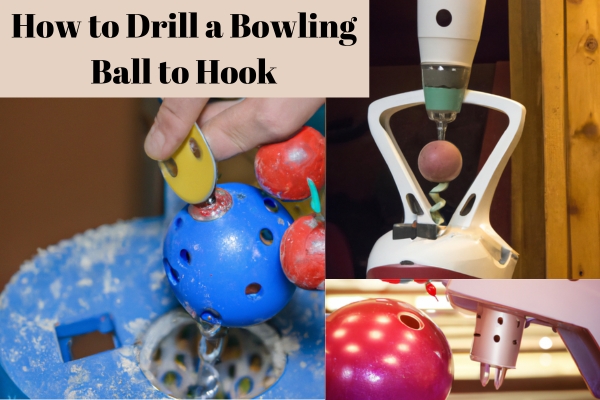Are you looking to take your bowling game to the next level? Learning how to drill a bowling ball to hook can significantly elevate your performance on the lanes. Whether you’re a beginner or an experienced bowler, understanding the techniques behind drilling a ball for a hook can be a game-changer.
In this comprehensive guide, we’ll discuss the intricacies of drilling a bowling ball for optimal hook potential while keeping it simple and straightforward.
How to Drill a Bowling Ball to Hook: Unveiling the Art of Enhancing Your Game

Before diving into the drilling process, grasp the fundamentals. Understand the hook potential, its impact on your game, and how drilling influences ball motion. A hook allows the ball to curve, enhancing control and hitting power.
Selecting the Right Ball
The type of ball matters! Choose a ball that complements your playing style and skill level. Reactive resin balls tend to offer a strong hook potential, while urethane balls provide more control.
Finding Your Positive Axis Point (PAP)
The easiest way to identify your PAP is to locate the spot on your ball where it rotates the least. It helps determine the ball’s preferred drilling layout, impacting its hook potential.
Determining the Drilling Layouts
Drilling layouts are crucial as they dictate the ball’s reaction. Layouts differ based on the bowler’s PAP and bowling style. Understanding these layouts optimizes the ball’s hook potential.
Identifying Your Bowling Style
Are you a stroker, tweener, or cranker? Your bowling style influences the drilling technique. Each style requires a unique drilling layout for optimal hook potential.
Customizing the Drilling Process
Make the drilling process as specific as you need it to be. Communicate effectively with your driller, discussing your preferences, and fine-tuning the drilling layout for a perfect match.
Working with a Professional Driller
You should seek the advice of a skilled professional. A certified driller possesses expertise in understanding your needs, offering advice, and executing precise drilling to enhance your ball’s hook potential.
Testing and Adjusting the Process
After drilling, it’s time for trial and error. Test the drilled ball on the lanes, analyze its reaction, and make necessary adjustments to achieve the desired hook.
Maintaining Your Drilled Bowling Ball
Regular maintenance is key to preserving the drilled ball’s performance. Clean the ball after use, keep it away from extreme temperatures, and periodically resurface it.
Experimenting with Various Drilling Techniques
To further enhance your bowling ball’s hook potential, don’t shy away from experimenting with different drilling techniques. It is possible to improve ball reaction by making minor adjustments. Collaborate closely with your driller to explore various drilling patterns and layouts that suit your style.
Adapting to Lane Conditions
It is extremely important to understand lane conditions. Oily or dry lanes can drastically affect your ball’s hook potential. Learn to adapt by altering your technique or ball speed to maximize the ball’s hook potential under various lane conditions.
Fine-Tuning Your Release
Your release technique plays a pivotal role in the ball’s motion. Work on your release by adjusting the revolutions and axis tilt. Experiment with the hand position and wrist action to fine-tune your release for a better hook.
Beyond the Hook: Focus on Technique
While drilling for a hook is essential, don’t neglect the importance of mastering bowling fundamentals. Focus on your stance, approach, and follow-through. A solid foundation in technique complements the ball’s hook potential.
Developing a Practice Routine
Consistent practice is key to honing your skills. Develop a structured practice routine that encompasses drilling techniques, lane adaptations, release variations, and overall gameplay improvement.
You can also learn about 10 Best Hex Shank Drill Bits.
FAQs:
How does drilling affect a bowling ball’s performance?
Drilling influences the ball’s motion, creating a hook potential that enhances control and hitting power.
Can I drill my bowling ball myself?
It’s highly recommended to seek assistance from a certified driller to ensure precise drilling for optimal results.
What should I consider when selecting a ball for drilling?
Consider your playing style, skill level, and the type of ball material as they greatly impact the drilling process.
How often should I clean my drilled bowling ball?
Clean your ball regularly after use to maintain its performance, preventing oil absorption and preserving its hook potential.
Is it necessary to adjust the drilling layout after initial testing?
Yes, testing the ball on the lanes helps identify necessary adjustments for achieving the desired hook; tweaking the layout might be required.
Can I use the same drilling layout for different bowling balls?
While some layouts might work across different balls, it’s recommended to customize layouts based on each ball’s characteristics for optimal performance.
How long does it take to master the hook technique?
Mastery varies for individuals. Consistent practice, coupled with patience and persistence, is key to refining your hook technique.
What’s the role of ball surface in enhancing hook potential?
Altering the ball surface with sanding or polishing can impact its traction on the lane, affecting the hook potential. Experimentation helps find the ideal surface for your style.
Conclusion:
I hope, In this article, you have learned about how to drill a bowling ball to hook and Mastering the art of drilling a bowling ball to hook is a journey that enhances your gameplay. Understanding your unique needs, choosing the right ball, and collaborating with a professional are pivotal in achieving that perfect hook.
Thank you for the reading!
